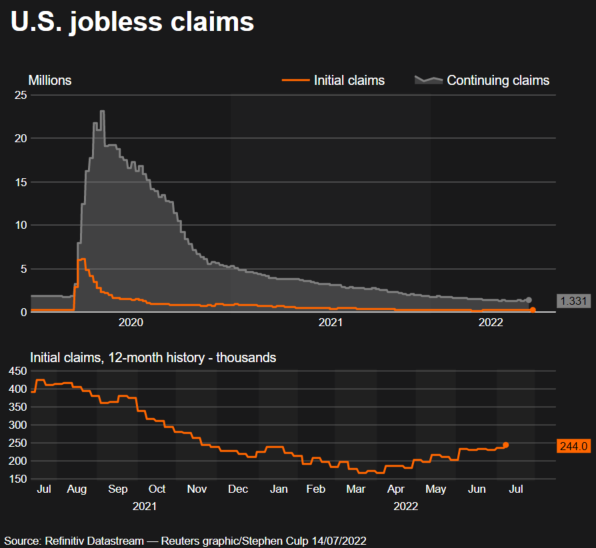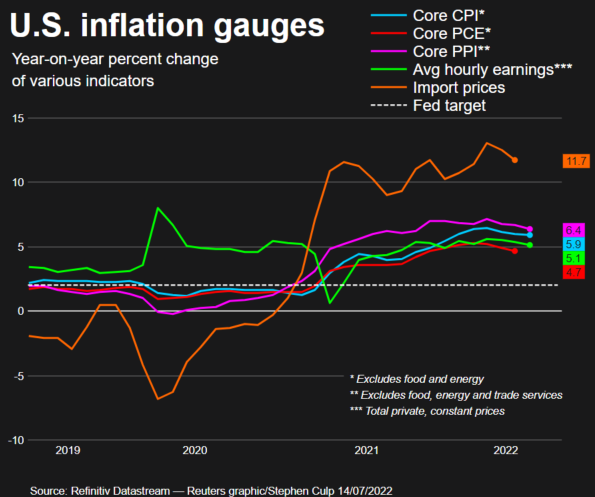U.S. Weekly Jobless Claims Hit 8-month High; Labor Market Still Tight

The number of Americans filing new claims for unemployment benefits increased to an eight-month high last week, suggesting some cooling in the labor market amid rising interest rates and tighter financial conditions.
Despite the second straight weekly rise in claims reported by the Labor Department on Thursday, labor market conditions remain tight, with very few people on unemployment rolls. Claims at current levels are inconsistent with an imminent recession, economists said. The Federal Reserve is raising borrowing costs to dampen demand for workers and ultimately slow the overall economy as it battles to bring inflation down to its 2% target.
"Rising jobless claims may be a first sign of a loosening labor market, but with openings still very elevated it is hard to view the market as anything but tight," said Isfar Munir, an economist at Citigroup in New York. "A sustained rise in claims is often a leading indicator of recession, but it would be premature to take away that message at this point."
Initial claims for state unemployment benefits rose 9,000 to a seasonally adjusted 244,000 for the week ended July 9, the highest since mid-November 2021. Economists polled by Reuters had forecast 235,000 applications for the latest week.
There have been reports of layoffs in the interest rate-sensitive housing and manufacturing industries.
Unadjusted claims jumped 21,384 to 241,314 last week. New York state reported a surge of 10,209 in its claims.
There were notable increases in Kentucky, Indiana, Ohio, Connecticut, Pennsylvania and Arizona, some of which could be related to the automobile industry. Auto manufacturers normally idle assembly plants for annual retooling in early July, though a global semiconductor shortage has forced many to adjust their schedules. California, Georgia and New Jersey reported significant declines in claims.
Graphic: Jobless claims graphic-

Even with the loss of momentum, demand for labor remains strong. There were 11.3 million job openings at the end of May, with nearly two job openings for every unemployed person. Claims remain below recession levels.
"As a very rough rule of thumb based on the last 40 years, we would view a move in jobless claims above 300,000 as sounding a yellow alert and above 350,000 as putting the economy on red alert," said Conrad DeQuadros, senior economic advisor at Brean Capital in New York.
Stocks on Wall Street fell while the dollar rose against a basket of currencies. U.S. Treasury prices were mostly lower.
GLIMMERS OF HOPE ON INFLATION
The government reported last Friday that the economy created 372,000 jobs in June, with a broader measure of unemployment falling to a record low.
The number of people receiving benefits after an initial week of aid fell 41,000 to 1.331 million during the week ending July 2, the claims report showed. The so-called continuing claims, a proxy for hiring, are not too far from levels last seen in late 1969.
With the labor market still tight and inflation showing no signs of subsiding, the Fed is set to raise its policy rate by another 75 basis points at the end of this month. That was reinforced by Fed Governor Christopher Waller who said on Thursday he supported a 75-basis-point hike at the July 26-27 meeting.
A separate report from the Labor Department also showed an acceleration in producer prices in June. That data followed on the heels of news on Wednesday that annual consumer prices surged 9.1% in June, the largest increase since November 1981.
The Fed has raised its overnight interest rate by 150 basis points since March.
The producer price index for final demand increased 1.1% last month after rising 0.9% in May. Prices were boosted by a 10.0% jump in energy, reflecting higher costs for gasoline, diesel fuel, electric power and residential natural gas.
Wholesale food prices gained 0.1%. The cost of services rose 0.4%.
Graphic: Inflation graphic-

But there are glimmers of hope that inflation could peak soon. Crude oil prices have fallen sharply, with the global benchmark Brent trading below $100 per barrel after surging to $139 in March, which was close to the all-time high reached in 2008. Other commodity prices are also coming off the boil.
Underlying wholesale inflation slowed in June. Excluding the volatile food, energy and trade services components, producer prices rose 0.3% in June. The so-called core PPI increased 0.4% in May. In the 12 months through June, the core PPI advanced 6.4% after rising 6.7% in May.
That marked three straight months of deceleration, reflecting easing supply bottlenecks.
"Cooler producer price pressures will start to make a difference, unless, of course, some new supply-side disaster unfolds," said Will Compernolle, a senior economist at FHN Financial in New York.
Compernolle also noted that spiking prices of essential goods were causing consumers to cut back on other products, slowing price increases of the related merchandise.
"That kind of decision making has been absent since the first pandemic rescue plan in the spring of 2020, but it appears to be making a comeback now. It is the first step to ultimately taming inflation," he said.
© Copyright Thomson Reuters 2024. All rights reserved.





















